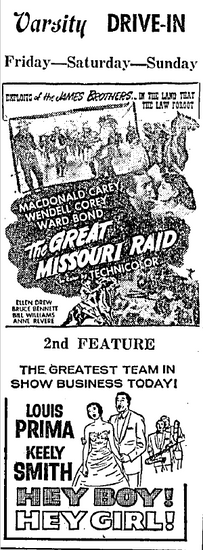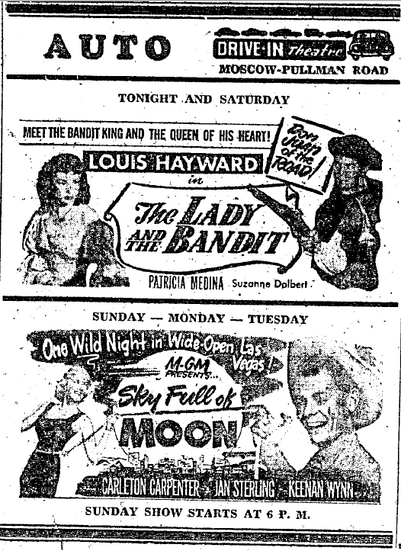Under the Palouse Skies: The Era of Drive-In Theaters
- LCHS

- Aug 1
- 5 min read
This article first appeared in the July/August 2025 edition of Home & Harvest magazine.
By Kaitlynn Anderson, Museum Curator

One of my fondest childhood memories is going to the drive-in movie theater with my family. On the 45-minute drive, my parents would stop to pick up a Little Caesar’s pizza and let us pick out candy at the Dollar Tree. Once we arrived at the drive-in, we had to look for the best parking spot available where we could get the greatest possible view of the screen. While the previews were showing, my brothers and I would join the other kids on the wooden ship playground and swing set. All the kids rushed back to their respective vehicles once the first movie of the night started. We would never stay awake long enough to watch the second movie. Reminiscing on my drive-in theater memories and experience makes me consider the history of that form of outdoor entertainment.
The first drive-in movie theater appeared in New Jersey in 1933 on ten acres of land and featured the film Wives Beware. The theater was built by Richard Hollingshead, who aimed to create an entertainment space that was accessible to families, particularly those with small children. During the process of creating the first drive-in, Hollingshead also patented the parking logistics for patrons. The original drive-in could accommodate roughly 400 vehicles, and the cost per vehicle was twenty-five cents with an additional twenty-five cents per person in the car. The screen at the theater was 40 feet by 50 feet and utilized a simple projector with speakers on either side of the screen.

After individuals and businesses learned about Hollingshead’s drive-in, they aspired to create their own model, but with some improvements. Patrons had a difficult time hearing Hollingshead’s audio speakers, so others tried to improve that feature. One of the most notable enhancements was the in-car speaker system. Located at each parking space was a wooden post with a speaker. Patrons attached the speaker to the top of the door window and rolled the window up, so the speaker was inside the vehicle. This improvement allowed audiences not only to hear the audio better but also created a more private and intimate viewing setting.
Another improvement was the addition of a concession stand. Items for purchase included the favorite movie-goer’s snack, popcorn, but also candy, hamburgers, and hotdogs. We might not think too much of having a concession stand available at the movies or other events, however, fast food would not become widely popular until the 1950s. Many drive-ins even added specialty services, such as bottle warming, pony rides, and car washes to enhance the movie-going experience.
By 1958, there were approximately 5,000 drive-ins throughout the country, mostly in rural areas. The demand and growth of drive-ins throughout the country can be credited to the post-World War II birth of the baby boomer era. As individuals returned from the war and the number of families increased, drive-ins became a family-friendly activity where children could play and be noisy, unlike at a typical sit-down movie theater. Thanks to the enactment of the G.I. Bill in 1944, suburban communities were created outside of urban city centers, which required residents to have vehicles. New vehicles unavailable during the war and unrationed gasoline allowed cars to become more popular and attainable to individuals and families. Traveling to and visiting drive-ins seemed to be a natural fit for the nation post-war. Drive-ins provided a place for families to spend time together, young couples to go on dates, and kids to have mischievous fun. Opportunities were presented for audiences to be social, yet private at the same time.

The Palouse was not exempt from the trend of drive-in theaters. Although Moscow did not have any, Pullman had three drive-in theaters. The first drive-in on the Palouse, located on the state border along Airport Road, was the Auto Theatre, later named Varsity Theatre. The drive-in opened on August 4, 1950, and was owned and operated by Edward Metzgar. Some of the amenities included a parking lot to accommodate a total of 466 cars, indoor bathrooms, and a concession stand, which is where most revenue was made. With the success of the drive-in, Metzgar eventually opened four additional drive-ins in Lewiston, Grangeville, Clarkston, and Richland. However, his many business ventures occupied too much of his time and Metzgar sold the Pullman business to Donald and Ellen Boyd in 1960. The Boyd family operated the business by running the concession stand, projecting the films, maintaining the grounds, and selling tickets. Eventually, the drive-in closed and was torn down in July 1974 under the ownership of James Ayling. According to an Argonaut article, the drive-in showed adult films the last few years it operated. What was a family-friendly activity had transitioned into one that was for adult eyes only. Many questions come to mind about the legality of showing adult films outdoors, regulation of the films and patrons, and attendance numbers.
Since the Varsity Drive-In proved to be profitable, it wasn’t too long until other drive-ins opened in the area. Closer to downtown Pullman, the Pullman Drive-In opened in 1952 by Russell Tate and Jack Hutchinson. Previously located where the Pullman Trailer Court was, this drive-in is now where Paradise Creek Trailside Taproom and other businesses stand. This drive-in provided different amenities compared to the Varsity Drive-In. For instance, there were only 300 parking spaces, but the screen was the largest in the area, measuring 62 feet tall and 60 feet wide. Even with these changes, the drive-in only remained open for two years. Speculative reasons for its closure could be that the land was too expensive to pay for, there was not enough room to expand since this was a flood plain, or other competing drive-in theaters.
Big Sky Motor Movie opened on present-day Wawawai Road on the outskirts of Pullman in 1953. Operating on leased land, the drive-in was owned by LaVance Weskil, but was eventually sold to Milburn Kenworthy a few years later. Kenworthy, who was known for owning the Kenworthy and Nuart Theaters in downtown Moscow, utilized the manager that Weskil hired to run the drive-in. Big Sky Motor Movie included 475 parking spaces, which was more than both competing Pullman drive-ins. One of the memorable features that many remember about the drive-in was the cowboy sign at the entrance of the parking lot. Movies continued to play at Big Sky Motor Movie until its closure in 1983. It was the last standing drive-in on the Palouse.
The downfall of local drive-ins followed the national trend of other drive-in closures throughout the country. The decline of drive-in theaters can be credited to the rise in popularity and size of televisions and the creation of videocassette recorders (VCRs). This decrease is reminiscent of the decline of traditional movie theaters today. Streaming services allow families to watch movies in the comfort of their own homes, allowing ease and rambunctious children in much the same way that drive-ins catered to families. This expansion of technology was not the only cause of the decline of drive-ins. Since most of the theaters were in rural areas, the cost of the land was too expensive to lease as commercial and residential land development was intensifying. Today, there are roughly 300 active drive-in theaters in the United States. It makes one wonder: how long until drive-in theaters are extinct? The nostalgia factor might be the saving grace for the remaining drive-ins, as well as the lower ticket costs compared to a regular movie theater. The rise in screens and use of technology is driving many to seek out these “old fashioned” ways of entertainment reminiscent of another generation.














Comments